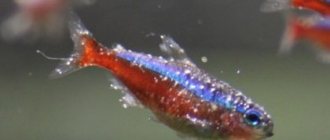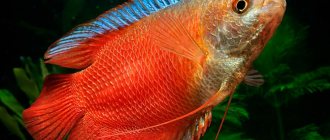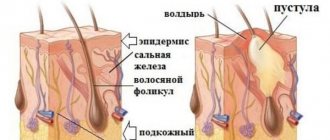Where does it come from?
Pathogen bacteria live in natural bodies of water, entering the aquarium through soil, food, decor, or from new fish purchased at the store. Therefore, it is better to immediately place aquarium fish in forced quarantine, and not place them with the rest of the aquarium inhabitants. You just need to leave them for a few days in an old tank with store-bought water, gradually adding water from your aquarium to it.
With fin rot, it is the fins of the fish that suffer, losing their former appearance - they tear and become worn out. Many beginners mistake this for the result of mechanical damage, so they do not take any action. In this case, the disease progresses quite quickly, which leads to the death of aquarium fish.
There are several main causes of infection:
- insufficient care of the aquarium, failure to clean it in a timely manner;
- lack of a filter, so the water inside is not clean enough;
- increased acidity level;
- incorrect temperature in the tank;
- various factors that can cause stress in fish;
- rotting plants in the aquarium;
- improperly selected food, which leads to a deficiency of essential microelements and decreased immunity.
Causes
Every aquarium has bacteria that cause fin rot and this is normal. They pose no threat to fish if their immunity can resist them. But these bacteria can attack if the fish’s immunity is weakened due to unfavorable conditions, and these are the conditions that are good for the proliferation of these bacteria.
If the causative agent of fin rot begins to develop rapidly, then without taking measures, the fish itself will not cope and will die.
Fin rot can occur due to:
- the fish has received severe stress or constant stress
- There are rotting plants in the aquarium
- water temperature below normal
- water temperature is above normal
- improper care of the aquarium, not timely replacements, bottom siphoning.
- incompatible fish in the aquarium - if the fish are aggressive and damage their fins, then through such a wound the bacteria can easily enter the body
- improper feeding of pets - a lack of necessary substances in the body leads to a weakening of the fish and a decline in its immunity.
Before buying, you should carefully examine the fish and inspect the fins. If the fins are destroyed, then it is not advisable to buy such fish. Since when moving fish and launching it to a new place, the fish is stressed and at this moment the pathogens of fin rot can attack the body of the weakened fish.
Main symptoms
The symptoms of this disease are quite characteristic, so it can be easily identified. With this pathology you can notice:
- cloudiness of fins;
- the appearance of red spots and stripes is a consequence of blockage of blood vessels;
- change in the color of the fins, which become bluish (the color changes from the edges, gradually spreading over the entire surface);
- breaking off fins;
- the appearance of ulcers throughout the body - this occurs at the last stage of the disease, so the probability of death of the aquarium fish is very high.
Symptoms of the disease
The disease is characterized by the presence of clearly visible symptoms. Red spots appear on the fins. This clogs the blood vessels, which interferes with blood circulation, and the fin begins to decompose. In addition, the fins look cloudy and frayed. The fin rays may become shorter. At a later date, ulcers appear in the place where the fins grow. In this case, the fish cannot be cured.
The disease is contagious, transmitted from sick creatures to healthy ones. Therefore, when you buy a new pet, be sure to keep it in quarantine for 1.5-2 weeks.
Who is most likely to get fin rot?
Any fish that has a weakened immune system can become infected with these diseases. But most often those who suffer are those with fairly large fins that form folds. These are guppies, angelfish, cockerels, goldfish and other species.
The further treatment strategy depends on the type of aquarium inhabitant. For example, bettas can recover under quarantine conditions, while angelfish do not tolerate being moved to another tank well.
At the same time, recovered individuals do not always restore their previous appearance of fins. Often there is a noticeable reduction in size and uneven edges.
Causes and symptoms
The causative agent of fin rot disease is the bacteria Aeromonas, Vibrio, Pseudomonas. Usually, the immune system of healthy fish resists them well, but if the inhabitants of the aquarium are weakened, have experienced stress, or live in insufficiently favorable conditions, they can easily become victims of bacteria.
A sick fish develops a white coating on the edges of its fins, their edges become uneven, rotting, and their color fades. The behavior of the fish also changes: it becomes lethargic and does not show normal appetite. In the later stages of the disease, the surface area of the fins is significantly reduced and they turn into rags. In fry, especially viviparous fish such as guppies or mollies, the caudal fin is often completely destroyed. In adult fish, rotting reaches the base of the fin, and when they are completely destroyed, ulcers with a whitish edge form at this place, and the fish dies.
As long as the muscles and blood vessels are not affected, treatment is still possible. Unfortunately, fish with a destroyed anal, dorsal or pectoral fin no longer have a chance.
Fin rot can affect any fish, but species with long and veiled fins are especially susceptible to it - cockerels, all types of angelfish, veiled forms of goldfish, guppies. The surface of their fins is larger and thinner (remember the delicate veils of guppies and goldfish), and is more vulnerable to bacteria. Unfortunately, it is also difficult for these species to return to their previous shape after recovery - the fins may lose their former even shape during recovery. For example, in angelfish that have suffered from disease, the rotted edges of the “feather” are thinner than the fin that was not affected by the disease. The growing rays of the fins may have knots or an irregular bend, similar to a break.
Return to content
How to treat fish for fin rot?
The success of treatment directly depends on how timely it was started. If symptoms are detected in individuals, it is necessary to move them into a separate tank, and clean the aquarium itself.
In the initial stages of the disease, changing the water daily by 30% and increasing its temperature to the maximum permissible values helps. You need to find out what the maximum temperature is for each type of fish and choose an average that would be suitable for everyone. If these actions do not help, then you can move on to more intensive treatment, which involves the use of medications and household products.
Methods for treating fin rot in fish
At an early stage of the disease, it is enough to clean the aquarium: clean the filter, remove all vegetation, disinfect the soil and all household items, refresh the water by 30%, increase the temperature.
The causative agents of fin rot are bacteria of the Vibrio, Pseudomonas and Aeromonas groups. These bacteria multiply very quickly and settle on fish fins. The causative agents of the disease are usually found in natural bodies of water and often it is from there that they enter the aquarium to the fish. There are also many bacteria in live food, water, algae, aquatic plants and soil.
Fin rot is a rapidly progressive disease that causes rapid erosion and subsequent disintegration of the fins. The course of the disease in young fish begins with the disintegration of the fins on the belly and tail; in adult fish this sequence is not observed. First, pathology of the fins occurs at their edges, gradually moving towards its base.
The very first sign of fin rot is a blue-white clouding of the fins that forms at their edges. The blue-white border on the fin subsequently expands and soon covers the entire fin. This is more noticeable in young fish, since their fins are almost transparent.
Another symptom of rot is spots and red stripes on fish fins. They are thought to be caused by a blockage in the blood vessels, also called fin blockage.
Rotting fins can become inflamed at the edges, and if this infection is not eliminated for a long time, it will soon be transmitted to the fin base. The fins will gradually become smaller due to the falling off of the ends of their rays. But still the split is not very deep. In young fish, the fin tissue dissolves completely.
As the disease progresses, small ulcers begin to appear at the bases of the fins. They are white in color due to the liquid that covers the base with a thin light layer. If you do not take immediate measures to treat your aquarium fish, the infection will spread to the entire body of the fish. The tissues are gradually destroyed and after some time the fish dies. Often with fin rot, clouding of the surface of the eyes is also observed.
In the early stages, fin rot can be treated very successfully. First you need to change the water in the aquarium, a maximum of a third of its total volume. Then you should raise the temperature to the maximum possible for sick fish. But at the same time, you should not forget about healthy fish, since some of them may not tolerate too high a temperature. If such are present, then sick fish should be treated separately from the rest.
If the fish continue to get sick after all the procedures, then you need to use medication.
We suggest you read: Can a cat eat chicken? Is it possible to feed a cat raw meat and why is the product dangerous?
Levomycetin helps well in the fight against fin rot. One tablet is per 20 liters of water. The tablet is well crushed to a powder and dissolved in a small vessel and all the liquid is poured into the aquarium. Levomycetin dissolves quite poorly, so you need to wait a little. Every 3 days it is necessary to change a third of the water in the aquarium and at the same time add the next portion of the medicine. This treatment is carried out until the diseased fish recover completely.
If sick fish are treated in an aquarium with healthy fish, then streptocide is used. 1.5 grams of medicine per 10 liters of water. Like chloramphenicol, streptocide is first dissolved in a separate container and then the liquid with the medicine is poured into the aquarium. Streptocide is also poorly soluble in water, like chloramphenicol.
You can also treat fin rot with streptocide in a separate container. Then one tablet of streptocide is dissolved in 6 liters of water. The water temperature should be approximately 27-28°. Keep sick fish in this solution for about half an hour.
A good remedy for treating rot is Bicillin-5. This medicine is sold in bottles of 1,500,000 units. To do this, 1/6 of the bottle is dissolved in 10 liters of water. Then the resulting liquid is poured into a bowl and the sick fish are placed there for half an hour. The course of treatment lasts 6 days. One bottle of Bicillin-5 is enough for this time.
Another effective cure for fin rot is Biseptol-480. It is sold in tablets, so you must first thoroughly grind it into a fine powder. Add 1/8 of the tablet to 5 liters of water. The course of treatment with Biseptol-480 lasts 7 days. Sick fish must be kept in the medicine constantly and aeration must be carried out.
Fin rot can be successfully treated even with the most common salt. To do this, you need to dissolve 3 teaspoons of salt in 5 liters of water in a separate container and then place the sick fish there. If the fish are too sensitive to salt, then instead of 3 teaspoons of salt, only 2 are given. It is important to remember that callicht catfish should not be treated with this method.
When the fish are treated separately from the rest, then a general disinfection of the aquarium is carried out with a chloramine solution. All aquarium equipment, soil and decorations are boiled in water. Algae and other plants are washed with a solution of Bicillin-5.
As described above, fin rot occurs due to injuries and unfavorable environmental conditions. Fish that have a weakened immune system are more susceptible to this disease. All of these factors can sometimes be present simultaneously. However, fin injury is not always the cause of the disease, especially if the fish is absolutely healthy.
There may be many more medications and different treatment methods, but these are the most effective medications to date for treating fin rot:
- streptocide;
- malachite green;
- bicillin-5;
- main purple K;
- chloramphenicol (tablets);
- copper sulfate;
- biomycin;
- biseptol-480;
- 0.5% chloramine solution;
- 3% hydrogen peroxide solution.
- The fins begin to become cloudy at the edges, a light blue border appears, which gradually expands - it is easier to notice the signs in young fish with translucent fins;
- Reddish spots and stripes - one of the symptoms of blockage of blood vessels in the fins, also begin from the edges;
- Inflammation of the edges of the fins, they will split and shorten;
- Whitish ulcers may form on the surface of the fins: if the disease is not treated, they spread to the entire body;
- In some fish species, the eyeballs begin to become cloudy;
- Loss of scale segments.
We suggest you read: Treatment of pneumonia in red-eared turtles
Damage to the fins is only external symptoms; in fact, the bacterial infection penetrates much deeper, affecting the muscles and internal organs, which is why it is very important to start treatment in a timely manner and isolate sick individuals.
You can introduce an infection into an aquarium if you failed to withstand the quarantine and introduced new residents into the tank; pathogenic bacteria are also transmitted with live food or bad water. Rot can begin as a result of injury to the fins, so check that all the fish in your pond are compatible and that it is not overcrowded.
If after a couple of days the disease continues to progress, you need to start drug treatment.
- Salt baths. They are not suitable only for catfish. Dissolve 1 teaspoon of table salt in 2 liters of water and place the fish here for about 20-30 minutes. Take baths for 5 days;
- Levomycetin. We buy tablets at the rate of 1 piece per 20 liters of water, grind them thoroughly, dissolve them in a separate container (it will take a long time to dissolve) and then pour them into the aquarium. After 3 days, you need to change 30% of the total amount of water and add a new dose of medication;
- Streptocide. At the rate of 1.5 grams per 10 liters. The scheme is the same as with chloramphenicol;
- Bicillin-5. Mainly sold in ampoules (dissolve only 1/6 part per 10 liters of water). Pour water into a basin and place the sick fish there for half an hour, repeat the course for 6 days;
- Biseptol-480. 1/8 of the tablet per 5-liter jar, the tablet must first be ground and dissolved in water. We place the fish in this container for a week, the solution should be new every day
You can also use other drugs to treat fin rot, the most well-known are Antipar, Biomitsin, Fiosept, Sulfonamide, Chloramphenicol, Malachite green, Antibak, chloramine solution, hydrogen peroxide 3% and others.
- Follow fish feeding schedules;
- Change the water and clean the aquarium in a timely manner;
- Keep fish with compatible species to avoid fin injury;
- Do not overpopulate the aquarium;
- Maintain quarantine when introducing new fish;
- Monitor the health of the tank inhabitants.
Fin rot responds well to treatment, the main thing is to start it in a timely manner.
(Visited 10 times, 1 visits today)
How to treat fin rot with medications?
How to treat fish in an aquarium if changing conditions does not help? There are several options here. There are specialized drugs for this disease that can be bought in specialized stores. There are a number of household methods that also show their effectiveness.
Here are just a few possible remedies:
- Streptocide. It is diluted in warm water, then poured into a tank (or hotel baths are made for infected individuals).
- Levomycetin. The antibiotic is diluted in a glass of settled water, then poured into the aquarium (ratio - 1:20). The procedure is repeated every 3 days.
- Furacilin. One tablet is enough for 30 liters. Treatment continues for up to 14 days.
- Biseptol-480. One quarter of this tablet is enough for 10 liters of water. It is important that the aquarium inhabitants are constantly in this solution until they recover.
- Bicillin-5. Consumption – one bottle per procedure (there will be 6 in total). To prevent the antibiotic from decomposing, it is necessary to ensure that the aquarium is darkened during treatment.
- Hydrogen peroxide (3%). Mixes with water separately, i.e. Do not pour peroxide directly into the tank, as this can cause burns to the fish. The duration of treatment is from 7 to 14 days.
Among the specialized products used to treat aquarium fish, we note Antipar. This is a solution consisting of formaldehyde, malachite green and blue. On average, therapy continues for a week (it is necessary to turn off filtration, aeration, and also exclude exposure to sunlight).
Description of the disease
Another name for the disease is pseudomonosis.
This is an infectious disease of bacterial etiology. The causative agent is bacteria of the Vibrio, Pseudomonas and Aeromonas groups. Often pseudomonosis is a secondary disease accompanying systemic bacterial diseases. Did you know? The world's smallest aquarium with inhabitants has dimensions of 3x1.5 centimeters.
This disease is of bacterial origin and is highly contagious. The main culprits of its development are considered to be pathogenic bacteria Aeromonas punctata and Pseudomonas fluorescens.
A common sign of infection is red spots on the fish's body and fins. Without treatment, the disease progresses very quickly and leads to the death of the inhabitants of the aquarium/pool. Therefore, it is important to notice the first signs of infection in time and prevent its spread.
It is difficult to cure young fish; the mortality rate among them from this disease is high. Adults recover more often, but their fin shape is not restored - they remain shortened with uneven edges, their rays are broken and knotted. If the ulcers spread to the body, then most likely the individual will die.
Cleaning the aquarium of bacteria is very desirable for a truly effective and sustainable treatment result.
To disinfect, remove decorations made of plastic and artificial materials from the aquarium, clean and adjust the filters. Rinse the soil and pour boiling water over it, disinfect all equipment. To disinfect plants, they can be kept for 4-5 days in a solution of biomycin or streptocide.
Try to be attentive to your pets, make sure that they live in favorable conditions, and then there will be much fewer threats to their health. Moreover, we are talking not only about good content, but also about psychological comfort. If one of your fish becomes the object of aggression from other inhabitants of the aquarium, then, no matter what ideal conditions it is in, the disease can happen to it.
How to treat pet aquarium fish with salt?
Treatment of fin rot is also possible using folk remedies. Many aquarists begin to treat their fish with salt, using the standard dosage - 7 g per 6 liters of water. Infected individuals are placed in this solution for 30 minutes (2 times a day).
It should be borne in mind that not all varieties of aquarium inhabitants tolerate salt water well, so for some individuals this method is unacceptable.
How to prevent the development of the disease
Usually only fish with weakened immune systems become infected with fin rot. Therefore, preventing infection with Pseudomonas fluorescens consists primarily of good care of aquarium inhabitants. To prevent infection, it is also necessary to disinfect new soil before laying it. You should not plant any plants taken from ponds, lakes or rivers in an aquarium. Among other things, too low a water temperature can provoke the development of fin rot in fish. Therefore, it is imperative to monitor the correct operation of the thermostat.
(Visited 245 times, 1 visits today)
How to treat fin rot in a betta?
To cure an aquarium fish, it is necessary to take into account the characteristics of a particular species. The scheme of further treatment depends on this. For example, consider a cockerel.
When the first symptoms appear in this fish, there is no need to immediately use medications. To begin with, you can disinfect plants, soil and decor. It is necessary to replace a third of all water, raise the temperature to the maximum permissible values (for this individual). Such conditions must be maintained for several days.
If this does not help, then you can use specialized tools. As a rule, they can be treated in a community aquarium, diluting the product in the dosage indicated on the package.
Prevention
To reduce the risk of disease, especially if you have a fish breed with beautiful long fins, follow a few rules:
- Change 30% of the water weekly with new water and at the same time clean the bottom of the aquarium. Remember, adding water is not the same as replacing it!
- Feed your fish high quality food and do not overfeed.
- When purchasing new inhabitants, be sure to quarantine them for 10 days.
- Place fish separately if there are any doubts about their health.
- Do not use someone else’s equipment or undisinfected soil.
- Maintain optimal conditions for keeping fish.
- Add preventative medications to the aquarium water. Most often, basic violet K or malachite green (sold in veterinary pharmacies) are used for this purpose, however, when using these products, you should be careful and follow the prescribed dosage so as not to harm the fish.
So, fin rot is a dangerous and highly contagious disease. But with timely treatment, it is possible not only to restore the fish’s fins, but also to save the lives of most pets.
0
0
Copy link
Prevention methods
There are a number of ways to prevent the occurrence of fin rot. The main one is keeping the aquarium clean. It is necessary to change the water periodically - once a month (for large ones), or once every 3 days (for small ones). It is necessary to wash the soil and all the decor inside the tank.
Another important point is overpopulation of the aquarium. It is important to prevent this from happening and also to ensure that there are no conflicts in the aquarium. For example, catfish and angelfish are quite aggressive towards more friendly inhabitants.
Which fish get sick more often?
The following types of aquarium fish are most susceptible to attack by fin rot:
- cockerels (symptoms: the red color of the fins changes to white-blue, white spots appear on them, erosions, fin rays break off and become loose);
- angelfish (symptoms: fins become covered with red stripes, spots, begin to collapse, and over time ulcers appear on the body of the fish);
- guppies (symptoms: fins begin to turn pale, thin and fall off);
- goldfish (symptoms: fins become cloudy, their edges are split, shortened);
- cichlids (symptoms: the fins become covered with a white coating, then the fin rays are affected and the tail is destroyed);
- swordtails (symptoms: slow destruction of fins, erosion of the tail, dorsal fin, appearance of a white coating).
Aquarium fish are most often susceptible to fin rot. Fish with long and veiled fins are at particular risk:
- angelfish;
- guppy;
- cockerels;
- veiltails (“goldfish”), etc.
Pond fish in cage farms can also suffer from the bacteria in question, but for them this disease is less common. According to our observations, it is young salmon that are susceptible to this disease. For them, the source of infection is considered to be adult sick individuals and their corpses.
We suggest you read: Treatment of scabies in cats (demodectic mange)










